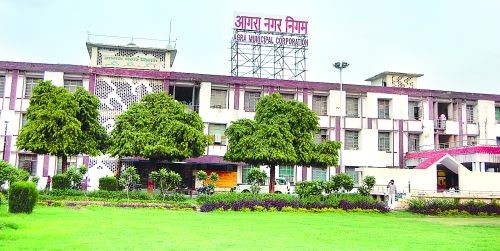Corporation
Agra Municipal Corporation or Agra Nagar Nigam (आगरा नगर निगम ) is the Municipal Corporation responsible for the civic infrastructure and administration of the city of Agra in India. The organization is also known as AMC or ANN. This civic administrative body administers the city’s cleanliness and other public services like public health and parks. ANN is very well known for managing the city by using private sector participation as well as the introduction of innovative mechanism in management to serve people efficiently. The Municipal Corporation has prepared different plans for improving services and to nullify the gap between services and demands. The AMC is responsible for public education, correctional institutions, libraries, public safety, recreational facilities, sanitation, water supply, local planning and welfare services. The mayor and councillors are elected to five-year terms.

Agra city is of historic importance, which is amply evident from the numerous historical monuments in and around the city. The hindu epic Mahabharata refers to it as ‘Agraban’,part of Brij Bhoomi, the homeland of Lord Krishna. The earliest recorded history of Agra is its establishment by a local king in 1475. The city was the capital seat of Mughals in ancient times. The heritage of the city is linked with the Mughal dynasty but numerous other rulers also contribute to the rich past of this city. Agra was founded by Sikandar Lodi in the 16th century. It grew into an important power centre under the Delhi Sultan Sikandar Lodi and he shifted his capital from the Delhi in 1504. Babar also stayed in Agra for some time and introduced the concept of square Persian-styled gardens. Emperor Akbar built Agra fort and Jehangir did the beautification with gardens and palaces. The city has a proud possession of “Taj Mahal” the eighth wonder of the world, now declared as World Heritage Site. The post- Mughal era of Agra saw the rule of jats, Marathas and finally the British taking over the city. In addition to its historic importance, Agra is the main centre of political, economic, commercial and cultural activities.
For a city with a million-plus population that has grown at more than 25% in the last thirty years, the infrastructure development has failed to keep pace with population growth. The city of Agra has several such deficiencies and there is a need to make a substantial improvement in basic infrastructure prevailing in the city to raise the standards of health, sanitation, urban environment keeping pace with urbanization and growing population. The importance of Agra city as a leading tourist destination has to be kept in view while designing the system to make the city beautiful, attractive to the tourist visiting the city.
The city Agra is situated on the western bank of river Yamuna on National Highway(N-H-2)at about 200 km. From Delhi in the state of Uttar Pradesh. Agra is geographically located at 27 12′ North latitudes and 78 12′ East longitudes. The maximum temperature of Agra rises to 47 C during peak season and drops to a minimum of 3 C during the winter season. Agra is a tourist centre of international fame. River Yamuna enters the town from the north-east corner, flows towards south for same distance and then turns towards east. The city stretches for 9.0 kms along the river. The land on which the city has developed slopes from west to east in CIS-Yamuna area on the right bank of the river Yamuna.
